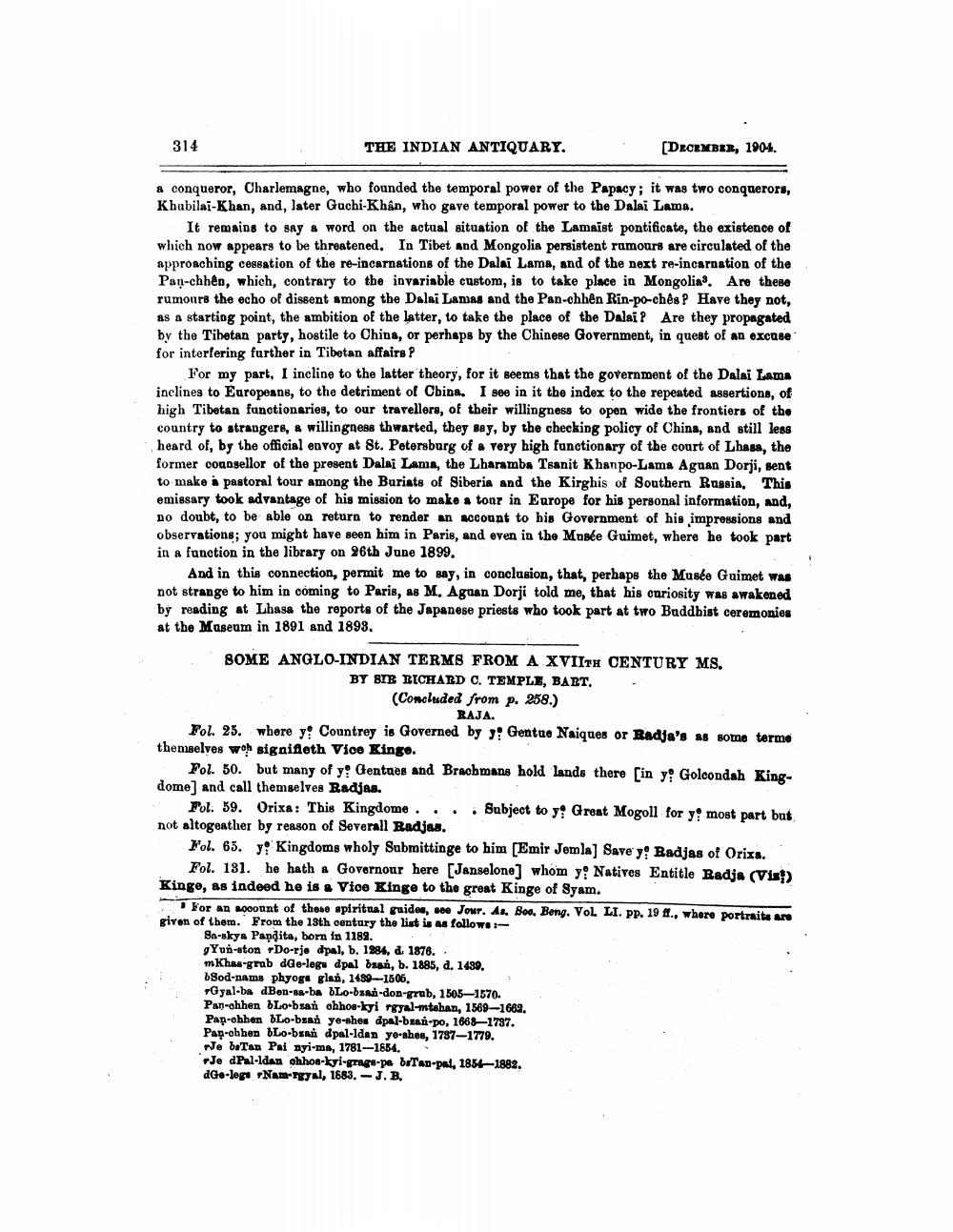________________
314
THE INDIAN ANTIQUARY.
[DECEMBER, 1904.
& conqueror, Charlemagne, who founded the temporal power of the Papacy; it was two conquerors, Khabilai-Khan, and, later Guchi-Khân, who gave temporal power to the Dalai Lama.
It remains to say & word on the actual situation of the Lamaist pontificate, the existence of which now appears to be threatened. In Tibet and Mongolia persistent rumours are circulated of the approaching cessation of the re-incarnations of the Dalai Lama, and of the next re-incarnation of the Pan-chhên, which, contrary to the invariable custom, is to take place in Mongolia. Are these rumours the echo of dissent among the Dalai Lamas and the Pan-chhên Rin-po-chês? Have they not, as a starting point, the ambition of the latter, to take the place of the Dalai? Are they propagated by the Tibetan party, hostile to China, or perhaps by the Chinese Government, in quest of an excuse for interfering further in Tibetan affairs ?
For my part, I incline to the latter theory, for it seems that the government of the Dalai Lama inclines to Europeans, to the detriment of China. I see in it the index to the repeated assertions, of high Tibetan functionaries, to our travellers, of their willingness to open wide the frontiers of the country to strangers, a willingness thwarted, they say, by the checking policy of China, and still less heard of, by the official envoy at St. Petersburg of a very high functionary of the court of Lhasa, the former counsellor of the present Dalai Lama, the Lharamba Tsanit Khanpo-Lama Aguan Dorji, sent to make a pastoral tour among the Buriats of Siberia and the Kirghis of Southern Russia. This emissary took advantage of his mission to make a tour in Europe for his personal information, and, no doubt, to be able on return to render an account to his Government of his impressions and observations, you might have seen him in Paris, and even in the Musée Guimet, where he took part in a function in the library on 26th June 1899.
And in this connection, permit me to say, in conclusion, that, perhaps the Musée Guimet was not strange to him in coming to Paris, as M. Aguan Dorji told me, that his ouriosity was awakened by reading at Lhasa the reports of the Japanese priests who took part at two Buddhist ceremonies at the Museum in 1891 and 1898.
SOME ANGLO-INDIAN TERMS FROM A XVIITH CENTURY MS.
BY BIB RICHARD C. TEMPLE, BART. (Concluded from p. 258.)
RAJA. Fol. 25. where y! Countrey is Governed by y Gentue Naiques or Radja's as some terme themselves woh signifleth Vice Kinge.
Pol. 50. but many of y! Glentaes and Brachmans hold lands there [in y! Golcondah Kingdome) and call themselves Radjas.
Fol. 59. Orixa: This Kingdome ... Subject to y Great Mogoll for y! most part but not altogether by reason of Severall Radjas.
Mol. 65. y Kingdoms wholy Submittinge to him [Emir Jomla] Save y! Badjas of Orixa.
Fol. 181. he hath a Govornour here [Janselone] whom yNatives Entitle Radja (Vis!) Kingo, as indeed he is. Vioe Kinge to the great Kinge of Syam. -
For an account of these spiritual guides, see Jour, As, Boo, Bong. VoL LI. PP. 1948., where portraits ar given of them. From the 19th century the list is as follows:
Sa-skya Pandita, born in 1182. gYun-aton Do-rje dpal, b. 1984, d. 1876. m Khas-grab dGe-legs dpal buah, b. 1885, d. 1439. Sod-nams phyogs glan, 1489---1506. Gyal-ba dBon-sa-ba bLo-ban-don-grub, 1505-1570. Pan-ohhen bLobsan ohhos-kyi rgyal-mtahan, 1569-1662. Pan.ohhen Lo-bxan ye-shes dpal-sa-po, 1668-1797. Pan-obhen bLo-bern dpalldan ye-shes, 1787-1779. Je botan Pai nyi-ms, 1781-1854.
Je dPal-ldan chhoa-kyi-graga-pe b#Tan-pal, 1854–1882. de-logo Nam-gyal, 1683.-J. B.




